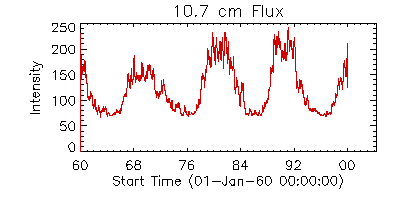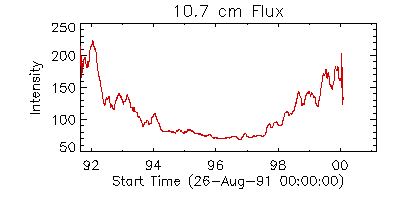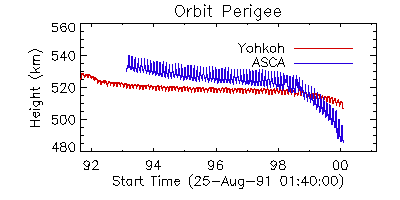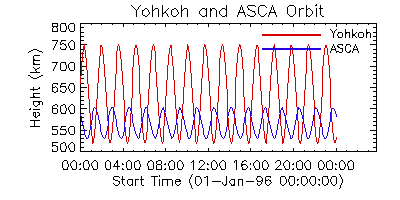
In light of the fact that Yohkoh has been in orbit for nigh on 9 years now, it seems appropriate to ponder whether this instrument is going to hang tough for another solar cycle, or are we headed for a watery grave in the next 6 months? Not so long ago Yohkoh was predicted to have a remaining lifetime of either 2 years or 6 years, depending on how strong the solar maximum was. Why is that? Fortunately there's a rich and long-lived database of information to tell us all about this, so let's have a look.
The first thing we'll do to avoid losing our readers is to delay the punch line until later, and first think about what the solar cycle looks like. In fact, over the last 40 years or so, solar activity (as defined by the 10.7 cm solar emission) looks like this:

The cycle peaks every 11 years or so. A full solar cycle is actually about 22 years, meaning we get two solar maxima per cycle. Now, let's expand the scale and look at the shorter period since Yohkoh launch in the latter half of 1991:

So its evident from this graph that we launched near solar maximum, and we're currently pretty darned close to another solar maximum. (Let the pundits decide if we've reached solar maximum yet or not. Or maybe relegate that to another nugget.) During solar maximum the Earth's atmosphere expands, since it is heated more by the X-rays that are so plentiful then. This, in turn, increases the drag on Yohkoh, which in turn slows down and slides into a lower orbit. If we do this long enough, of course, we'll go down the same road that SkyLab went down, e.g., into the Indian Ocean.

This plot shows the orbital degradation of Yohkoh since launch. The degradation at solar maximum is evident, with our spacecraft taking a minor plunge both shortly after launch, cruising flat for many years, and then dipping again around mid-1999. For comparison, we include similar quantities for ASCA. Does it seem puzzling that ASCA started out higher than Yohkoh, but is apparently rapidly heading for a fiery grave? Puzzle you should. These graphs are actually plots of the height of the satellite above ground at the perigee of the orbit.

"Eureka!", we proclaim: ASCA spends much more time down in the dregs of the Earth's atmosphere, where the atmospheric density tends to be higher (This time we're plotting the entire orbit, not just the height of perigee). Meanwhile, Yohkoh swoops through this atmospheric ghetto briefly and then heads back to more tenuous climes, extending the life of the orbit by a significant margin.